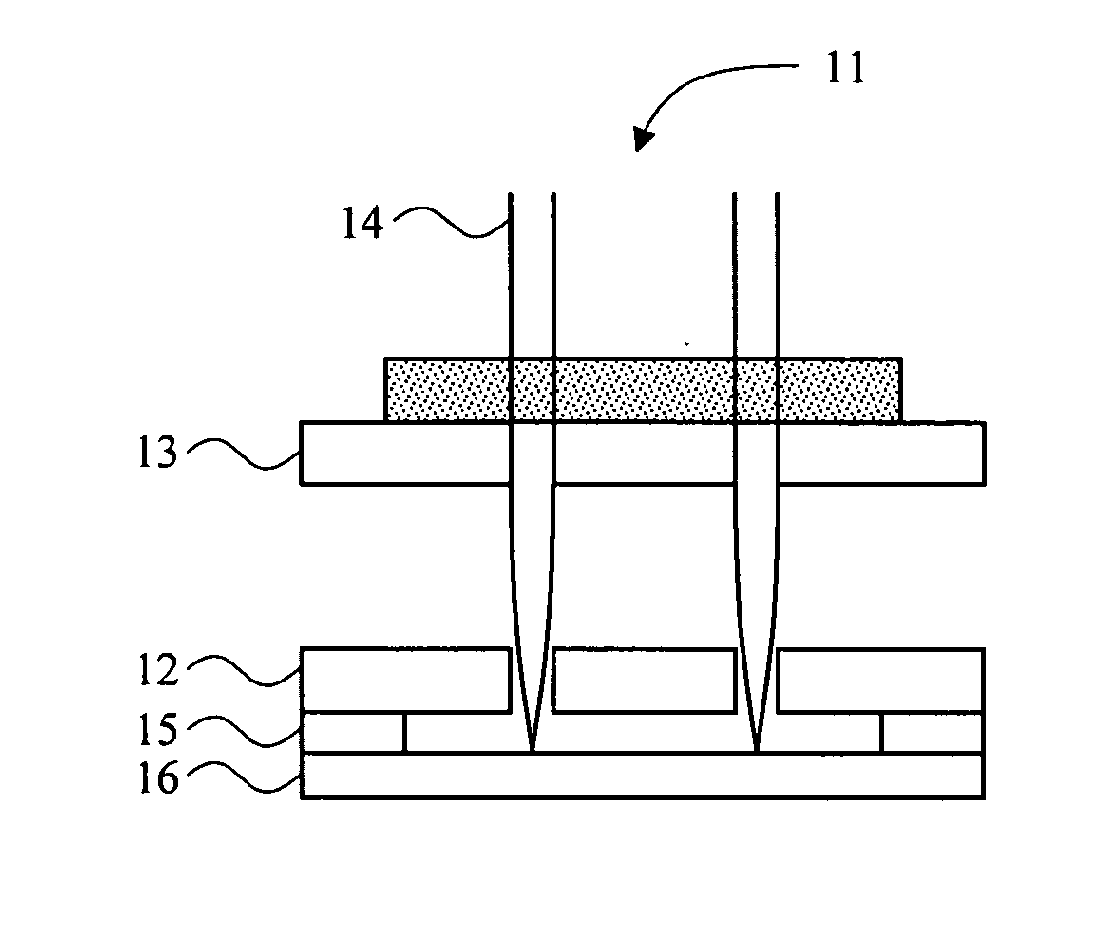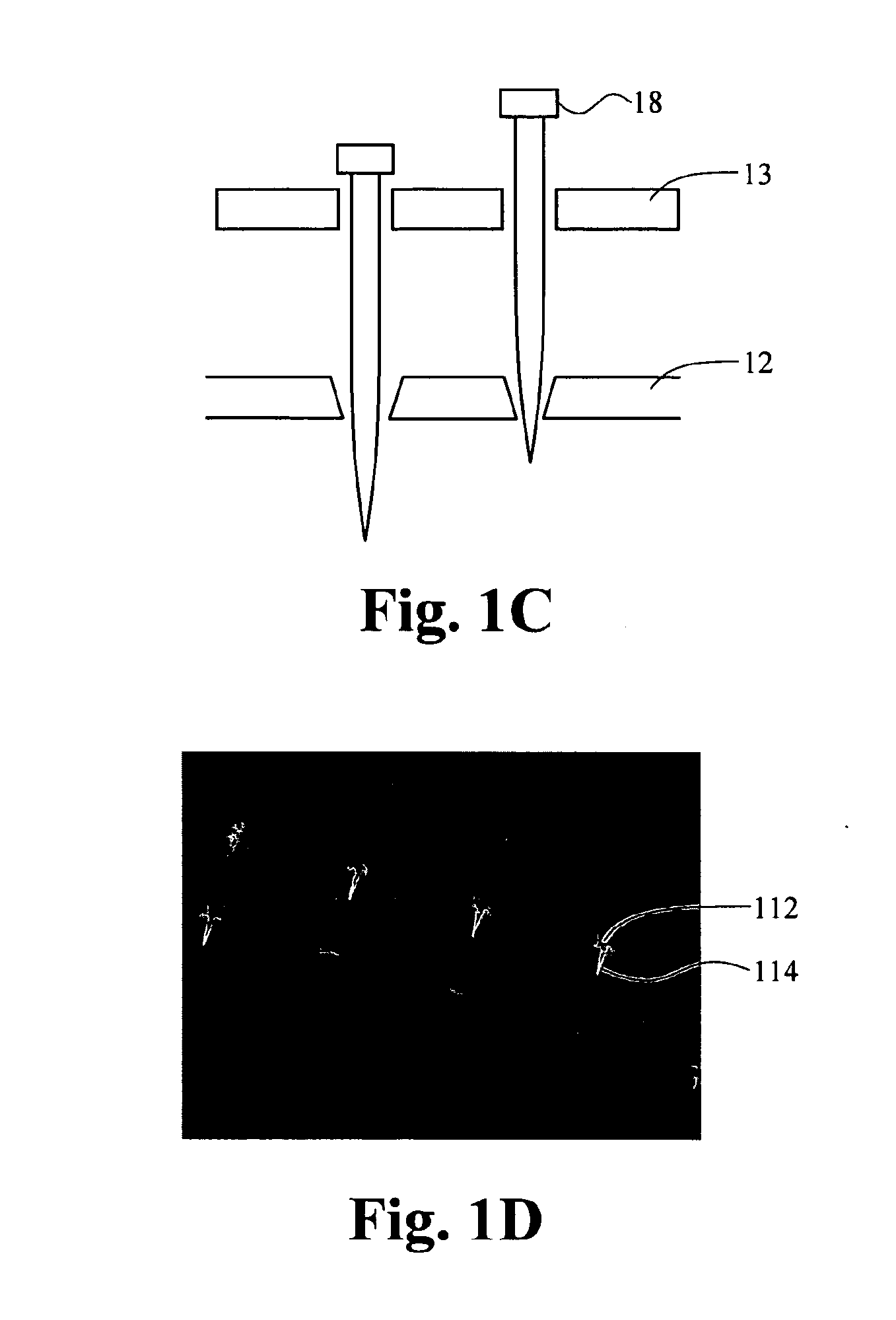Method of manufacturing solid solution peforator patches and uses thereof
a technology of solid solution and perforator, which is applied in the field of manufacturing solid solution perforator, can solve the problems of affecting the ability of microneedle array master microneedle to be manufactured, and affecting the quality of microneedle array master. the effect of reducing the number of microneedle arrays
- Summary
- Abstract
- Description
- Claims
- Application Information
AI Technical Summary
Benefits of technology
Problems solved by technology
Method used
Image
Examples
example 1
Fabrication Positive Master and SSPS from Silicone Mold
[0081]Holes were made in glass as shown in FIG. 1D by chemical etching through holes on a photoresist film patterned by photolithography and acupuncture needles were aligned through the holes 114. The tip of the needles through the holes are depicted. PDMS was poured on this side and cured overnight. 8% sodium methyl cellulose hydrogel was poured on this silicone mold and centrifuged at 3,000 rpm for 5 minutes. After centrifuging, the hydrogel was dried for one day and separated from the mold. FIG. 5 is the image of dissolvable microneedle made of cellulose. Another micromold from CNC profile forming grinding techniques is depicted in FIG. 1F.
example 2
Compression Break Force and Dissolution Time with Various Compositions
[0082]Compression testing was done with a force gauge (NexyGen DF series) and the conical compression force applied until the microneedles broke was measured. The test samples were prepared with various sugar derivatives and sodium carboxy methyl cellulose (SCMC). The 8% SCMC was mixed with DI water. The dissolution time for to fully dissolve the SCMC in 10 ml of DI water at 300 rpm was measured. Since the sugar derivatives were added to the fixed 8% SCMC hydrogel, the results were normalized over weight. Results are shown in Table 1.
TABLE 1Formulation compositionDissolution timeConical compression(SCMC:Lactose)(min)force (N)SCMC = 10010.81 ± 0.0311.27 ± 0.75SCMC:Trehalose = 91:910.73 ± 0.6317.13 ± 1.95SCMC:MaltoDextrin = 91:910.25 ± 0.3915.23 ± 5.24SCMC:Sucrose = 91:911.00 ± 1.0117.77 ± 1.08SCMC:PVP = 91:911.21 ± 0.9419.50 ± 6.66SCMC:Glucose = 91:910.59 ± 1.8810.61 ± 0.23SCMC:Mannitol = 91:911.07 ± 0.8616.15 ± 0....
example 3
Mechanical Properties with Different Lactose Compositions
[0083]Compression and dissolution tests were done on various compositions of lactose. As lactose was added, the test article dissolved faster and compression force increased. See, Table 2.
TABLE 2Formulation compositionConical compression(SCMC:Lactose)Dissolution time (min)force (N)SCMC:Lactose = 100:010.81 ± 0.03 11.27 ± 0.75SCMC:Lactose = 91:910.55 ± 0.24 18.03 ± 2.50SCMC:Lactose = 83:178.68 ± 0.1323.25 ± 0.21SCMC:Lactose = 77:237.87 ± 0.4521.87 ± 3.62SCMC:Lactose = 71:297.03 ± 0.1429.93 ± 6.94SCMC:Lactose = 67:337.02 ± 0.61 23.90 ± 13.75SCMC:Lactose = 62:387.79 ± 0.0539.57 ± 2.19SCMC:Lactose = 44:566.57 ± 0.0324.47 ± 1.11SCMC:Lactose = 29:714.58 ± 0.7545.56 ± 4.29SCMC:Lactose = 21:793.91 ± 0.6575.25 ± 2.20
PUM
| Property | Measurement | Unit |
|---|---|---|
| Time | aaaaa | aaaaa |
| Time | aaaaa | aaaaa |
| Time | aaaaa | aaaaa |
Abstract
Description
Claims
Application Information
 Login to View More
Login to View More - R&D
- Intellectual Property
- Life Sciences
- Materials
- Tech Scout
- Unparalleled Data Quality
- Higher Quality Content
- 60% Fewer Hallucinations
Browse by: Latest US Patents, China's latest patents, Technical Efficacy Thesaurus, Application Domain, Technology Topic, Popular Technical Reports.
© 2025 PatSnap. All rights reserved.Legal|Privacy policy|Modern Slavery Act Transparency Statement|Sitemap|About US| Contact US: help@patsnap.com



